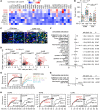The local immune landscape determines tumor PD-L1 heterogeneity and sensitivity to therapy
- PMID: 31112529
- PMCID: PMC6668685
- DOI: 10.1172/JCI127726
The local immune landscape determines tumor PD-L1 heterogeneity and sensitivity to therapy
Abstract
PD-L1 is a promising therapeutic target in aggressive cancers. However, immune landscapes and cancer hallmarks of human PD-L1+ tumors, as well as their roles in determining therapeutic efficacies are unknown. Here we identified, in detailed studies of gene data regarding 9769 patients of 32 types of human cancers, that PD-L1 could not exclusively represent IFN-γ signature and potentially signified pro-inflammatory myeloid responses in a tumor. PD-L1 heterogeneity endowed by local immune landscapes controlled cancer hallmarks and clinical outcomes of patients. Mechanically, NF-κB signal elicited by macrophage inflammatory responses generated PD-L1+ cancer cells exhibiting capabilities to aggressively survive, support angiogenesis, and metastasize, whereas STAT1 signal triggered by activated T cells induced PD-L1+ cancer cells susceptive to apoptosis. Importantly, PD-L1+ cancer cells generated by macrophages established great resistance to conventional chemotherapy, cytotoxicity of tumor-specific effector T cells, and therapy of immune checkpoint blockade. Therapeutic strategy combining immune checkpoint blockade with macrophage depletion or NF-κB inhibition in vivo effectively and successfully elicited caner regression. Our results provide insight into the functional features of PD-L1+ tumors and suggest that strategies to influence functional activities of inflammatory cells may benefit immune checkpoint blockade therapy.
Keywords: Cancer immunotherapy; Immunology; Inflammation.
Conflict of interest statement
Figures








References
-
- Xiao X, et al. PD-1hi identifies a novel regulatory B-cell population in human hepatoma that promotes disease progression. Cancer Discov. 2016;6(5):546–559. doi: 10.1158/2159-8290.CD-15-1408. - DOI - PubMed
Publication types
MeSH terms
Substances
LinkOut - more resources
Full Text Sources
Research Materials
Miscellaneous

